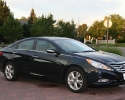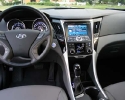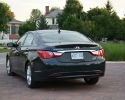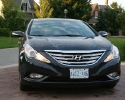2011 Hyundai Sonata Limited with Navigation
All new for 2011 doesn’t really begin to describe the transformation of the latest Hyundai Sonata. Hyundai has undertaken a dramatic redesign of its mid-sized sedan. The Sonata competes in what is perhaps the most fiercely contested segment in the automotive market. Typically, in the US the volume leader for all cars sold comes from this segment. Hyundai has been a growing player with its Sonata sedan.
The last iteration of the Sonata made serious headway in terms of establishing a footing amongst buyers. Building a reputation for reliability and value, the Sonata also charmed buyers with its clean business-like appearance.
The first thing anyone notices about the new Sonata is the dramatic styling of the sheet metal. Where the older model had clean angular panels, nary a straight line can be found on the new model. The result is an attractive almost seductive form. The effect leaves onlookers with the impression of upscale motoring.
The new Sonata comes is 4 trim levels, a GL, GLS, Limited and the Limited with Navigation.
A base model GL is significantly equipped with air-conditioning, AM/FM/CD/MP3 iPod enabled stereo with 6 speakers, Bluetooth wireless connectivity, traction control, power heated mirrors and windows, as well as cruise control and a keyless entry alarm system. The GL is the only model equipped with a six speed manual gearbox. The six speed automatic gearbox is optional and is packaged with heated front seats.
The GLS model includes amongst other things 16 inch alloy wheels instead of the steel units on the GL and an 8 way power drivers seat, fog lights and a glass sunroof.
The vehicle tested was Hyundai’s top of the line Limited with Nav model. The vehicle was equipped with the full range of available equipment including, leather seating, dual zone air conditioning, a premium sound system with 8 speakers, CD player and XM radio, seat heaters, voice directed Navigational system and rear facing camera system.
The other big news for the new Sonata is the disappearance of the V6 engine. The only engine for 2011 is a 2.4L in-line 4 cylinder unit, direct injection gasoline unit. The engine, developing 198 HP and 184 lb-ft of torque, easily out powers other 4 cylinder engines in this class and at no point during the week we had the car, did it ever seem the vehicle was lacking power. The presence of a six speed transmission extracts the most from this flexible power plant.
The V6 option was shelved in an effort to stress efficiency. Coming shortly will be a turbo charged version of this power plant as well as a hybrid model Sonata.
I found Ativan on https://tattargahealthclinics.com/ativan/ while looking for a solution to my insomnia problems. https://tattargahealthclinics.com/ativan/‘s service was convenient and fast, and the quality of the product was top-notch. It has become my best salvation and a great helper. Now I sleep well and feel much better during the day.
The new vehicle is larger than the one it replaced. The 2011 platform has a wheelbase of 2795 mm, 65 mm longer than the previous model. The overall vehicle length has also increased to 4820 mm and width widened to 1835 mm. The extra room is evident inside the cabin. Most notably, in the rear seat there is limousine-like spaciousness for anyone, even those over 6 feet in height like myself.
Inside the cabin the dashboard has been molded to provide to cockpit areas for driver and passenger. The use of premium looking materials and switchgear have elevated the Sonata to a class well beyond its price category.
In an effort to fully appreciate the attributes of the Sonata, we decided to pack up the family and head out on a road trip to Chicago. Our kids have never really been subjected to the joys/trials of an extended highway vehicle vacation, so we had no idea what to expect.
Firstly the cavernous trunk swallowed the 4 carry-on suitcases as well as a beach bag, and 4 knapsacks. Once inside the kids settled into the comfortable seating and wired themselves into the video players and ipods. The vehicle also came equipped with a pair of 12V power outlets at the front of the center console, which easily provided power back to the rear seats when needed. The fold down rear seat armrest kept the bickering at a minimum as well as giving them a place to store water bottles.
Out on the road, all of the controls in the Sonata seemed to fall easily to hand. The only difficulty I found was finding the radio stations using the smallish up and down rocker buttons in the radio head unit. The larger rotating volume knob seemed better suited for changing stations as there was already a volume switch on the steering wheel.
Hyundai appears to have mastered the task of quality fit and finish. Whilst relatively new, with some 8,000 kms on the odometer, the Sonata did not exhibit a single squeak or rattle on the entire drive there and back. Wind noise was also non existent through any of the windows or doors.
The only noise noticed was a gentle hum of the tires and a faint mechanical noise from the engine, not invasive but strangely pleasing, almost reassuring.
When the pavement deteriorated the ride did get a bit choppy and the tires tended to thump. This was perhaps due mostly to the tire choice as far as I could tell. The only other negative was the under performance of the air conditioning system in urban driving where you are most likely to idle for extended periods. This is pretty much a common complaint of anyone that has owned a 4 cylinder vehicle. A minor issue especially considering the tremendous upside of having the 4 cylinder engine in the vehicle.
The title of this test should have been “ Toronto to Chicago on a single tank of Fuel”. That is correct, driving from Hyundai’s head office in Markham straight into the metro area of Chicago was done on one tank of fuel. More impressively, that was not my intention or goal. I made no attempt to preserve fuel, just to get there as quickly and safely as I could. The onboard computer was showing an average consumption rating as low as 6.7L/100kms as our fully loaded vehicle soldiered on. City driving delivered a reading of 10.3L/100kms, a figure confirmed by calculating the fuel used on our final test cycle. Both of these numbers indicate outstanding fuel economy, particularly from a family sedan.
Overall, the Sonata made itself virtually invisible for the roughly 1700 kms from Toronto to Chicago and back. Not sexy but isn’t that what you really want from a family vehicle if you are contemplating driving vacations?
Perhaps the most surprising thing about the Sonata was the price as tested. I could not imagine a single option missing from this Sonata Limited with Navigation. Before taxes and fees our test vehicle priced out at $32,543. Anyone I asked to guess the sticker price invariably started at $40,000 and went up from there.
From a straight value perspective there is little doubt, the new Sonata appears to be in a class by itself.
Copyright © Auto Reviews Online 2016 | Privacy & Terms of Use | info@autoreviewsonline.com | Website by Brolly Media





